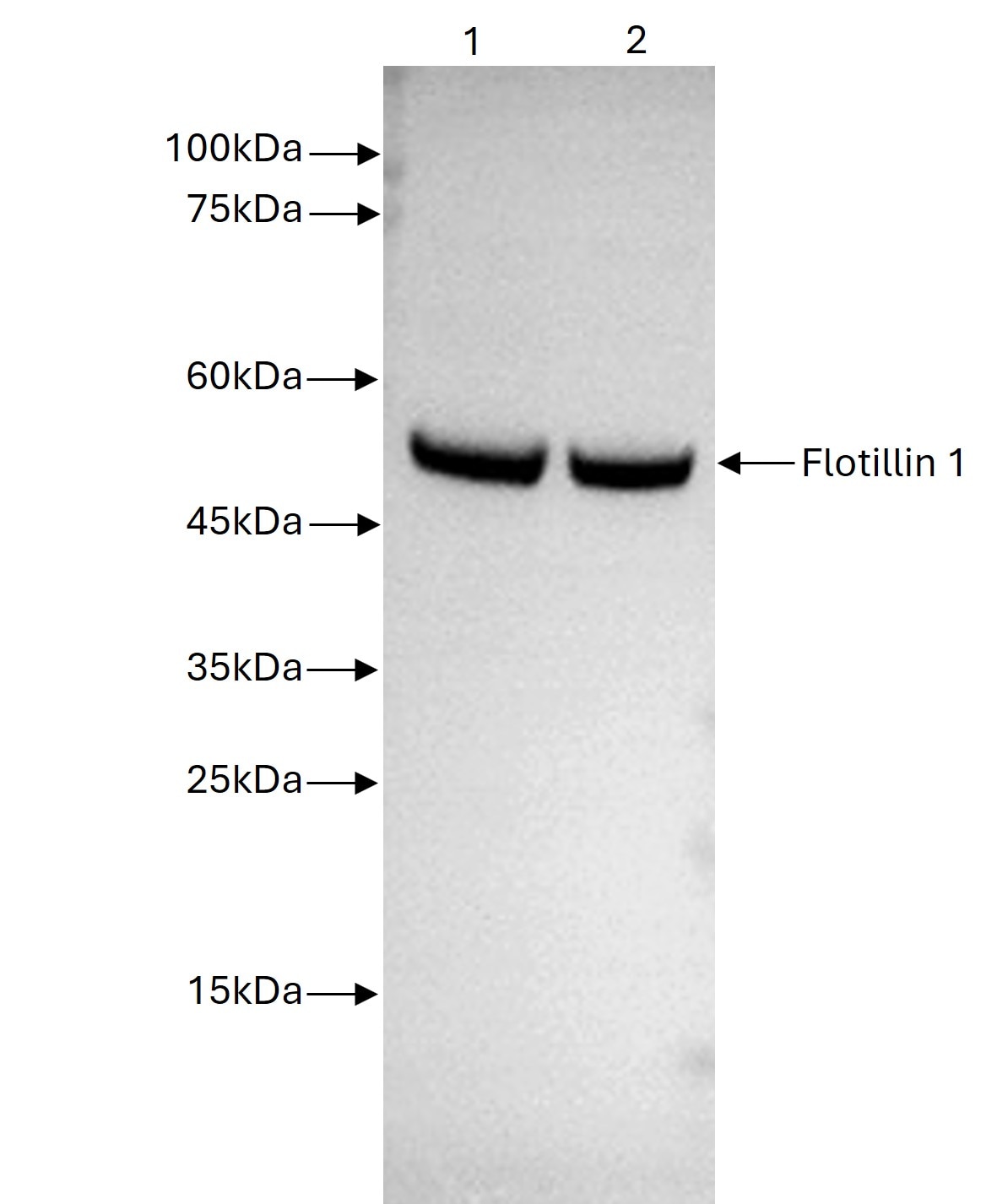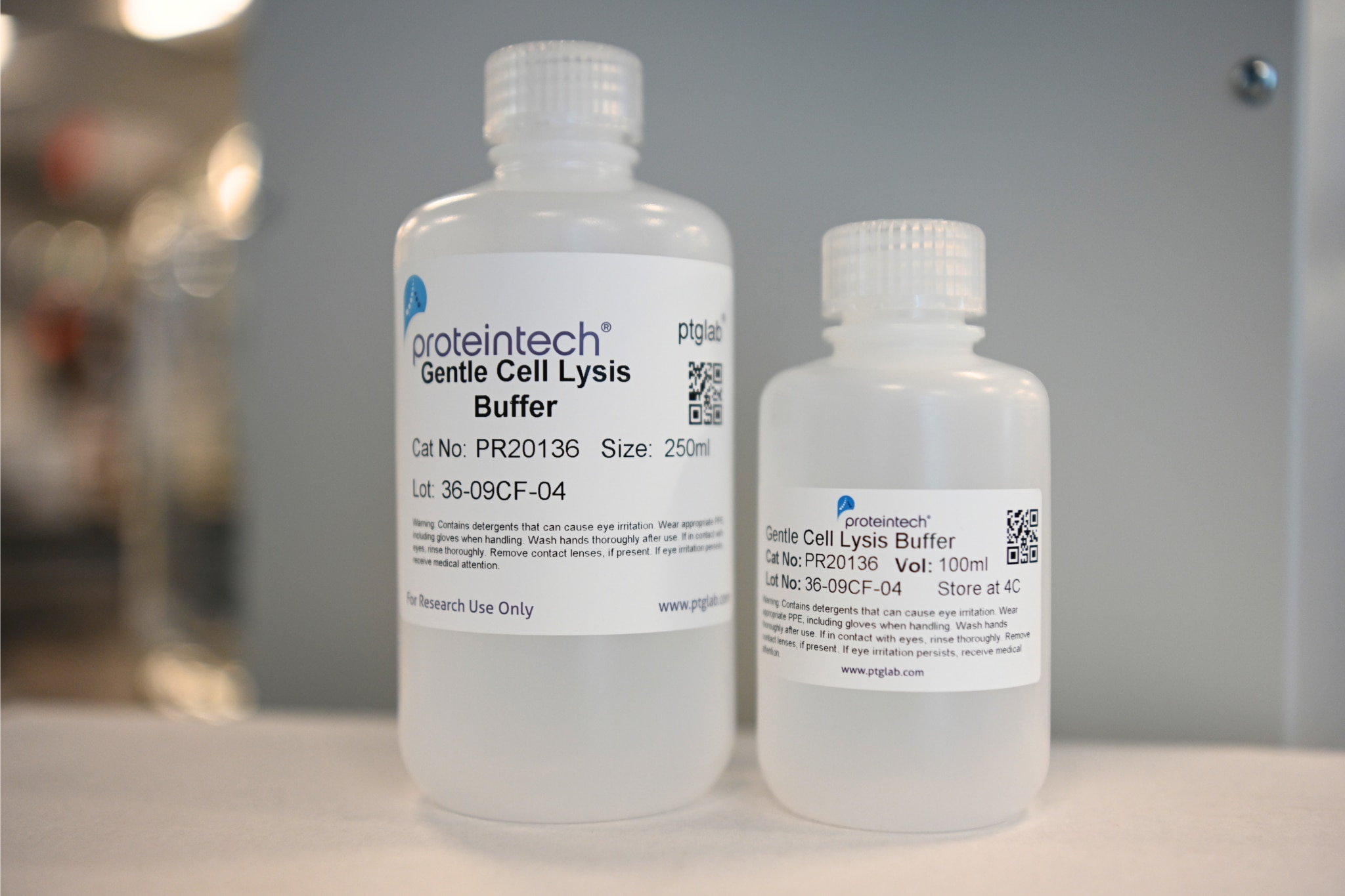Product Information
The Gentle Cell Lysis Buffer was developed by Proteintech to have mild lysis strength. It can be used to prepare protein lysates from cells and tissues for various applications including Western Blot, IP, Co-IP, ELISA, etc.
Components
The components of the Gentle Cell Lysis Buffer are TrisHCl (pH 7.4), NaCl, 0.5% NP-40, NaN3, and EDTA.
Storage
Store at 4°C for up to one year.
Usage
1. For cell samples
Take an appropriate amount of the lysis buffer and add protease inhibitors within a few minutes of use. For phosphorylation-related assays, add phosphatase inhibitors as well.
a. Lysing adherent cells
i. Aspirate the media from the cells and wash twice with pre-cooled PBS (use gentle movements to prevent cells from detaching). Aspirate the remaining PBS as much as possible.
ii. Add 1 mL of pre-chilled lysis buffer per 10 million cells to the cell culture flask or dish on ice and use a pipette and/or cell scraper to loosen the adherent cells. Collect the sample and transfer to an appropriate tube.
b. Lysing cells in suspension and drug-treated cells
i. Collect cells in suspension and centrifuge at 500 g at 4°C for 5 min. Remove the media but be careful not to disturb the cell pellet. Wash the pellet twice with pre-cooled PBS, spinning down between washes, and aspirate the remaining PBS as much as possible.
ii. Add 1 mL of pre-chilled lysis buffer per 10 million cells and place on ice for 30 minutes (inverting to mix every 10 minutes).
Note:
i. The collection of adherent cells is preferred since it can prevent cells from breaking during centrifugation, effectively improving the total protein yield, and retaining the extracellular matrix (ECM).
ii. For drug-treated adherent cells, centrifugation is recommended for collection because drug-treated cells are often not firmly adhered to the surface and are easy to lose during the PBS washing step.
iii. Some suspension cells with high cell viscosity (HEK-293) and high density (Jurkat, K-562, etc.) are prone to form flocculants after adding cell lysis buffer, and they should be dispersed by sonication.
iv. It is recommended to use an ultrasonic disruptor to assist in lysing samples for Western Blot, IP, ELISA, and other experiments. Sonication should be avoided for samples used for Co-IP.
2. For animal tissue samples
Take an appropriate amount of lysis buffer and add protease inhibitors within a few minutes of use. For phosphorylation-related assays, add phosphatase inhibitors as well. Take fresh animal tissue, wash the fat and blood and other impurities attached to the tissue block with pre-cooled PBS, and weigh it after absorbing the water with filter paper.
a. Liquid nitrogen grinding method: Add liquid nitrogen to the mortar with the cut tissue block and quickly grind it to a fine powder. Transfer powder to an EP tube, add 1 mL of pre-cooled lysate per 100 mg of tissue, and use a pipette to resuspend up and down and mix until completely dissolved.
b. Cryogenic grinding method: Turn on the cryogenic grinder in advance to precool. Cut the tissue sample into small pieces of about 1-2 mm and divide it into 2 mL centrifuge tubes (100 mg of sample per tube). Add a 5 mm grinding bead to each tube. Place centrifuge tubes into liquid nitrogen for quick freezing and transfer to the cryogenic grinder and grind at 65 HZ for 45 seconds. If more grinding is necessary, pause for 15 seconds and then repeat the grinding step. Add 1 mL of pre-chilled lysis buffer to each tube and use a pipette to resuspend up and down until completely dissolved.
c. Homogenization method: Cut the tissue blocks and place in a centrifuge tube on ice. Add 1 mL of pre-chilled lysis buffer per 100 mg of tissue. Transfer the sample to a pre-cooled glass homogenizer and homogenize the sample 30-50 times in an ice bath until fully lysed.
Note:
i. The liquid nitrogen and cryogenic grinding methods are preferred as they have the best results for total protein yield. The homogenization method may generate heat and speed up degradation.
ii. The cryogenic grinding method is used to grind quick-frozen samples that were in liquid nitrogen. Therefore, a special centrifuge tube is required that can withstand these temperatures.
iii. It is recommended to use an ultrasonic disruptor to assist in lysing samples for Western Blot, IP, ELISA, and other experiments. Sonication should be avoided for samples used for Co-IP.
For other types of samples such as plants and bacteria: Please refer to workflows for specific samples that have been published previously.
Cautions
1. The buffer does not contain any protease or phosphatase inhibitors. Therefore, these will need to be added prior to lysing your samples.
2. The protein content varies between different samples, and the volume of the lysis buffer can be adjusted accordingly.
3. A small mass of transparent colloid may appear in the lysate product corresponding to DNA. This can be broken up by sonication at low temperatures, followed by centrifugation at 10,000 g.
4. For your safety and health, please wear lab coats and disposable gloves to use this product.
5. This product is only used for scientific research and should not be used for clinical diagnosis or treatment.
Cited in Article as
PR20136, Gentle Cell Lysis Buffer, Proteintech, IL, USA




